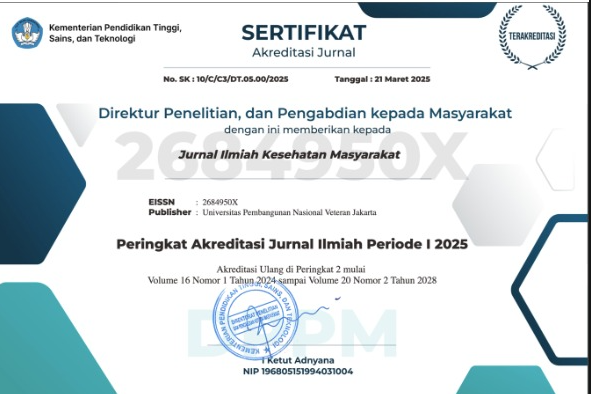Prevalence and Factors Associated with Hypertension among Adolescents in Peri-Urban Areas
Abstract
Background: Hypertension in adolescents is becoming an increasingly important health issue because it can continue into adulthood and increase the risk of cardiovascular disease later in life. The purpose of this study was to determine the prevalence of hypertension and pre-hypertension and to analyze the related factors in adolescents in peri-urban areas.
Methods: This study used a cross-sectional design conducted in October 2023 on 40 Christian Junior High School 4 Mebung students in Alor Regency. The sample selection was purposive, with inclusion criteria of 13–16 years old. Data were collected using structured questionnaires, interviews, and blood pressure measurements. Blood pressure was measured three times to ensure the accuracy of the measurement results. Data analysis included univariate analysis to describe the characteristics of the respondents and chi-square test to assess the relationship between independent variables (sodium intake, physical activity, parental history of hypertension, sleep duration, sleep quality, and stress) with hypertension status.
Results: Pre-hypertension prevalence was 30%, and hypertension was 20%. Three factors showed a significant relationship with hypertension: a history of hypertension in the father (p-value = 0.038), high sodium intake (p-value = 0.002), and sleep duration of less than 8 hours (p-value = 0.001). Other factors, such as a history of hypertension in the mother, physical activity, sleep disorders, and stress, did not show a significant relationship.
Conclusion: Hypertension in adolescents in peri-urban areas is related to genetic factors and lifestyle behavior. Prevention efforts need to be focused on low-sodium nutritional education, adequate sleep management, and routine blood pressure screening in schools.
References
Gakidou E, Afshin A, Abajobir AA, Abate KH, Abbafati C, Abbas KM, et al. Global, regional, and national comparative risk assessment of 84 behavioural, environmental and occupational, and metabolic risks or clusters of risks, 1990–2016: a systematic analysis for the Global Burden of Disease Study 2016. Lancet [Internet]. 2017 Sep;390(10100):1345–422. Available from: https://linkinghub.elsevier.com/retrieve/pii/S0140673617323668
Uthman OA, Ayorinde A, Oyebode O, Sartori J, Gill P, Lilford RJ. Global prevalence and trends in hypertension and type 2 diabetes mellitus among slum residents: a systematic review and meta-analysis. BMJ Open. 2022;12(2):e052393.
Mills KT, Bundy JD, Kelly TN, Reed JE, Kearney PM, Reynolds K, et al. Global disparities of hypertension prevalence and control: a systematic analysis of population-based studies from 90 countries. Circulation. 2016;134(6):441–50.
Mills KT, Stefanescu A, He J. The global epidemiology of hypertension. Nat Rev Nephrol. 2020;16(4):223–37.
Kementerian Kesehatan RI. Panduan Praktik Klinis Bagi Dokter di Fasilitas Pelayanan Kesehatan Primer. Jakarta; 2016.
Litwin M aw. Why should we screen for arterial hypertension in children and adolescents? Pediatr Nephrol. 2018;33(1):83–92.
Vidal-Petiot E, Ford I, Greenlaw N, Ferrari R, Fox KM, Tardif J-C, et al. Cardiovascular event rates and mortality according to achieved systolic and diastolic blood pressure in patients with stable coronary artery disease: an international cohort study. Lancet. 2016;388(10056):2142–52.
Kurnianto A, Kurniadi Sunjaya D, Ruluwedrata Rinawan F, Hilmanto D. Prevalence of Hypertension and Its Associated Factors among Indonesian Adolescents. Int J Hypertens [Internet]. 2020 Sep 16;2020:1–7. Available from: https://www.hindawi.com/journals/ijhy/2020/4262034/
Badan Kebijakan Pembangunan Kesehatan. Riset Kesehatan Dasar 2018. Jakarta; 2019.
Pidor AA, Manongga SP, Oematan GTS. Pengaruh Konsumsi Pangan Terhadap Tekanan Darah Pada Siswa SMA di Kecematan Oebobo Kota Kupang. J Pangan Gizi dan Kesehat. 2023;12(1):1–9.
Hansen ML, Gunn PW, Kaelber DC. Underdiagnosis of Hypertension in Children and Adolescents. JAMA [Internet]. 2007 Aug 22;298(8):874. Available from: http://jama.jamanetwork.com/article.aspx?doi=10.1001/jama.298.8.874
Moin A, Mohanty N, Tedla YG, Carroll AJ, Padilla R, Langman CB, et al. Under‐recognition of pediatric hypertension diagnosis: Examination of 1 year of visits to community health centers. J Clin Hypertens [Internet]. 2021 Feb;23(2):257–64. Available from: https://onlinelibrary.wiley.com/doi/10.1111/jch.14148
Metoki H, Kuriyama S. Combination of genetic and environmental factors for childhood hypertension: a simple indicator of family history remains useful. Hypertens Res [Internet]. 2023 Apr 25;46(4):1061–3. Available from: https://www.nature.com/articles/s41440-022-01165-y
Glenning J, Sheeran F, Quach J, Cheung M, Best S, Quinlan C, et al. Feasibility of School-Based Screening for High Blood Pressure in Children: The Healthy Hearts at School Study. J Hypertens [Internet]. 2024 May;42(Suppl 1):e102. Available from: https://journals.lww.com/10.1097/01.hjh.0001020320.07735.af
Saing JH. Hipertensi pada Remaja. Sari Pediatr [Internet]. 2016 Dec 5;6(4):159. Available from: https://saripediatri.org/index.php/sari-pediatri/article/view/873
Badan Kebijakan Pembangunan Kesehatan. Hasil Survei Kesehatan Indonesia. Jakarta; 2024.
Twinamasiko B, Lukenge E, Nabawanga S, Nansalire W, Kobusingye L, Ruzaaza G, et al. Sedentary Lifestyle and Hypertension in a Periurban Area of Mbarara, South Western Uganda: A Population Based Cross Sectional Survey. Int J Hypertens [Internet]. 2018;2018:1–8. Available from: https://www.hindawi.com/journals/ijhy/2018/8253948/
Metoki H, Kuriyama S. Combination of genetic and environmental factors for childhood hypertension: a simple indicator of family history remains useful. Hypertens Res. 2023;46(4):1061–3.
KC K, Katwal S, Yadav GK, Adhikari A, Thapa RK, Jha SK, et al. Family history of hypertension and its relation to other variables in hypertensive patients: a cross-sectional study from a tertiary care hospital. Int J Surg Glob Heal [Internet]. 2023 Sep;6(5):1391–2. Available from: https://journals.lww.com/10.1097/GH9.0000000000000235
Whelton PK, Carey RM, Aronow WS, Casey DE, Collins KJ, Dennison Himmelfarb C, et al. 2017 ACC/AHA/AAPA/ABC/ACPM/AGS/APhA/ASH/ASPC/NMA/PCNA guideline for the prevention, detection, evaluation, and management of high blood pressure in adults: a report of the American College of Cardiology/American Heart Association Task Force on Clinical Pr. J Am Coll Cardiol. 2018;71(19):e127–248.
Bonsang E, Caroli E, Garrouste C. Gender heterogeneity in self-reported hypertension. Econ Hum Biol [Internet]. 2021 Dec;43:101071. Available from: https://linkinghub.elsevier.com/retrieve/pii/S1570677X21000964
Yuan M, Yan D, Wang Y, Qi M, Li K, Lv Z, et al. Sodium intake and the risk of heart failure and hypertension: epidemiological and Mendelian randomization analysis. Front Nutr [Internet]. 2024 Jan 26;10(5):e1428–34. Available from: https://www.frontiersin.org/articles/10.3389/fnut.2023.1263554/full
Afshin A, Sur PJ, Fay KA, Cornaby L, Ferrara G, Salama JS, et al. Health effects of dietary risks in 195 countries, 1990 2017: a systematic analysis for the Global Burden of Disease Study 2017. Lancet. 2019;393(10184):1958–72.
He FJ, Tan M, Ma Y, MacGregor GA. Salt Reduction to Prevent Hypertension and Cardiovascular Disease. J Am Coll Cardiol [Internet]. 2020 Feb;75(6):632–47. Available from: https://linkinghub.elsevier.com/retrieve/pii/S0735109719386929
Mozaffarian D, Fahimi S, Singh GM. Global sodium consumption and death from cardiovascular causes. J Vasc Surg. 2015;61(2):567.
Erni Astutik, Septa Indra Puspikawati, Desak Made Sintha Kurnia Dewi, Ayik Mirayanti Mandagi, Susy Katikana Sebayang. Prevalence and Risk Factors of High Blood Pressure among Adults in Banyuwangi Coastal Communities, Indonesia. Ethiop J Health Sci [Internet]. 2020 Nov 1;30(6). Available from: https://www.ajol.info/index.php/ejhs/article/view/201963
El Assar M, Álvarez-Bustos A, Sosa P, Angulo J, Rodríguez-Mañas L. Effect of Physical Activity/Exercise on Oxidative Stress and Inflammation in Muscle and Vascular Aging. Int J Mol Sci [Internet]. 2022 Aug 5;23(15):8713. Available from: https://www.mdpi.com/1422-0067/23/15/8713
Butryn ML, Crane NT, Lufburrow E, Hagerman CJ, Forman EM, Zhang F. The Role of Physical Activity in Long-term Weight Loss: 36-month Results From a Randomized Controlled Trial. Ann Behav Med [Internet]. 2023 Feb 4;57(2):146–54. Available from: https://academic.oup.com/abm/article/57/2/146/6594650
Meyer SE, Kimber M, Maier LE, Matenchuk B, Moldenhauer R, de Waal S, et al. The impact of exercise training on muscle sympathetic nerve activity: a systematic review and meta-analysis. J Appl Physiol [Internet]. 2024 Aug 1;137(2):429–44. Available from: https://journals.physiology.org/doi/10.1152/japplphysiol.00060.2024
Adeke AS, Chori BS, Neupane D, Sharman JE, Odili AN. Socio-demographic and lifestyle factors associated with hypertension in Nigeria: results from a country-wide survey. J Hum Hypertens. 2024;38(4):365–70.
Liu X, Zhang D, Liu Y, Sun X, Han C, Wang B, et al. Dose-response association between physical activity and incident hypertension: a systematic review and meta-analysis of cohort studies. Hypertension. 2017;69(5):813–20.
Tomé-Carneiro J, Visioli F. Plant-Based Diets Reduce Blood Pressure: A Systematic Review of Recent Evidence. Curr Hypertens Rep [Internet]. 2023 Jul 13;25(7):127–50. Available from: https://link.springer.com/10.1007/s11906-023-01243-7
LAURA (Laboratorium Antropologi Untuk Riset dan Aksi). Pengembangan Model Penguatan Partisipasi dan Dukungan Komunitas Untuk Meningkatkan Akses Anak pada Pendidikan Yang Berkualitas. Yogyakarta; 2015.
Jiang W, Hu C, Li F, Hua X, Zhang X. Association between sleep duration and high blood pressure in adolescents: a systematic review and meta-analysis. Ann Hum Biol. 2018;45(6–8):457–62.
Tai BWS, Dawood T, Macefield VG, Yiallourou SR. The association between sleep duration and muscle sympathetic nerve activity. Clin Auton Res. 2023;33(6):647–57.
Isayeva G, Shalimova A, Buriakovska O. The Impact of Sleep Disorders in the Formation of Hypertension. Arter Hypertens [Internet]. 2022 Dec 29;26(4):170–9. Available from: https://journals.viamedica.pl/arterial_hypertension/article/view/86807
Hosokawa R, Tomozawa R, Fujimoto M, Anzai S, Sato M, Tazoe H, et al. Association between sleep habits and behavioral problems in early adolescence: a descriptive study. BMC Psychol. 2022;10(1):254.
Sic A, Bogicevic M, Brezic N, Nemr C, Knezevic NN. Chronic Stress and Headaches: The Role of the HPA Axis and Autonomic Nervous System. Biomedicines [Internet]. 2025 Feb 13;13(2):463. Available from: https://www.mdpi.com/2227-9059/13/2/463
Anavekar N. Stress and high blood pressure: What’s the connection? [Internet]. High Blood Pressure. 2024. Available from: https://www.mayoclinic.org/diseases-conditions/high-blood-pressure/in-depth/stress-and-high-blood-pressure/art-20044190?p=1
Laffin L. Do Stress and Anxiety Cause High Blood Pressure? Heart Health. 2022.









.jpg)








